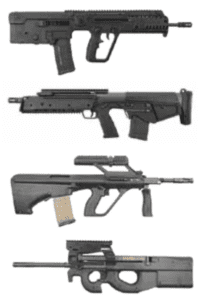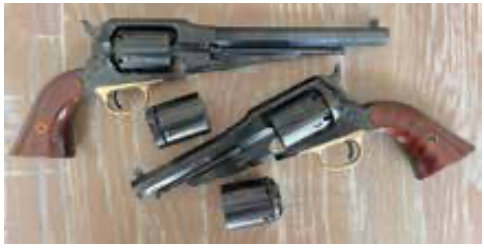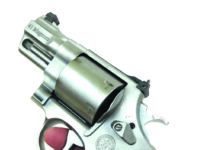Re “Cartridge-Conversion Cylinders From Taylor’s & Co.and Kirst,” November 2023
Your review of percussion pistol conversion cylinders in the November issue of Gun Tests was excellent. Very useful and informative. I have three assorted such cylinders by Taylor’s and know that many readers will appreciate your testing and instruction; it may even sway some hold-offs go ahead and order one. Your safety concerns were necessary also, in the event that someone tried to use the wrong type of ammo. Thank you. — Art
Hey Art: That was a very specialized article, but a lot of folks may want to take the leap as a result. — Todd Woodard
Made In Where?
I really appreciate your adding the “Made In” information to your modules when you review a firearm. Would it be possible for you to mention where an optic (conventional or red dot) is from when you discuss it? Whenever possible, I try to avoid made in China. I have little choice when shopping for a toaster oven, but when it comes to weaponry and the accoutrements, I don’t want to give my money to a nation that we might soon go to war with. I want to know if Brand A, at say $125, was made in China, while competitor Brand B, at say $175, was made in the Philippines, and Brand C, at say $300, was made in the USA. If I can afford an American product, I’ll buy it.
If my funds are limited, I don’t mind buying a product from another nation, such as the PI or Japan, provided that nation is a true ally. — Dave
Hey Dave: We generally only list the “made in” information for items that are being tested and for which we list a full set of specifications. But sure, when we test optics, we’re happy to include that line. — tw

Bullpups in the Works
First, I would like to compliment and thank you for providing such an interesting and informative magazine. I have found the evaluations very useful in guiding my purchases over the several years I have been a subscriber. I am currently interested in buying a bullpup rifle; therefore, I would appreciate it if you could include such an evaluation in an upcoming edition, particularly the Tavor X95 and the Springfield Hellion. — Jeff
Hey Jeff: Yep, we’ve got a bullpup match up in the works. It’s odd that I hadn’t seen a request for a test of these products for many years, but now, some interest. I’m betting it’s because of the Hellion. The last time we covered bullpups was in the January 2018 issue, “Running the Bullpups: IWI, Kel-Tec, Steyr, and FN Compete.” Of the 5.56mm-chambered rifles, we said of the IWI Model Tavor X95 XB16, “The IWI is an easy bullpup to adapt to because many controls are like an AR’s. We liked that caliber conversions were available. We liked that the rails could be hidden with the removable panels, and the IWI easily allowed the user to add accessories. Downside: The trigger was mushy. At $2000, we feel this is a good investment for a cutting-edge bullpup design with traditional AR-15 style features.” It earned an A- grade.
Of the Kel-Tec Model RDB 17, we said, “The Kel-Tec is a basic bullpup that, in our opinion, will get the job done. If you have a need to own a bullpup and have a limited budget, this would be our pick, thus its Best Buy ranking.” It got an A- grade.
Of the Steyr Model AUG A3 M1 w/3X Optic, we wrote, “Our Team Said: The Steyr is a well-made rifle with great ergonomics. It is also expensive. We liked this iconic option the best of these closely-ranked products, and if it is in budget, we’d go for it ahead of the others.” It was Our Pick and got an A- grade.
Of the FN Model PS90 Standard chambered in 5.7x28mm, we opined, “The PS90 is well made, reliable, and compact. The cartridge is not as popular as the 5.56mm, but it is proven. If you have a Five-seveN pistol, the PS90 would be a great companion piece. If a cutting-edge bullpup is your desire, then the PS90 is a great choice.” We gave it an A-.
I don’t think the products have changed much in the past five years, so if you’re particularly interested in one of those rifles, I’d encourage you to look it up in the on-line archives as part of your subscription. — tw
Re “Laser Range Finders Head to Head: We Test SIG vs. Leupold,” July 2023
While interesting, the data provided, specifically the Ranging Test, would have been much more useful and relevant if the testers had taken the time and effort to actually tape the distance so that the actual distance could be used as a basis for comparison of the range finders’ reports. The only object that had a true distance, the 45% IPSC Plate at 510 yards, was not reportable. Overall, very disappointing data. — Dan
Our object in these tests was not to establish a distance to the targets with accuracy that would do honor to a surveyor. Intermediate obstacles such as fences, tree lines, tall berms, busy roads, and creek beds would have made physical tape measurement impossible. Rather, it was to determine which items could be successfully lased, by which platforms, and to find, approximately, what their range limitations were. Witness the red 45% IPSC Target — all of the test range finders found that combination to be problematic. Because we were testing for potential failures, we considered that result to be a success.
We hope that our readers also found the information about the onboard software and links to existing applications to be useful as well. Please note that some were, indeed, more capable than others. — Joe Woolley
In the August edition you reviewed the Crossbreed Magna-Arm Gun Magnet as a method to secure a gun in a car. In today’s vehicles where everything is computer operated put a magnet anywhere near the car’s components is a very bad idea. These types of magnets are the rare earth type which has a very strong magnetic field. That can easily disrupt the computer chips causing automotive malfunctions. I would not recommend using them. — Charlie
Hey Charlie: Good advice. Gotta be careful. — tw





























